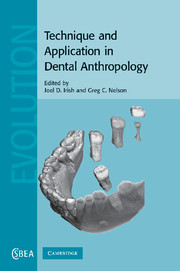Book contents
- Frontmatter
- Contents
- Contributors
- Acknowledgments
- Section I Context
- Section II Applications in assessing population health
- Section III Applied life and population history
- Section IV Forefront of technique
- 15 Methods of ingestion and incisal designs
- 16 Dental reduction in Late Pleistocene and Early Holocene hominids: alternative approaches to assessing tooth size
- 17 Dental microwear analysis: historical perspectives and new approaches
- 18 Virtual dentitions: touching the hidden evidence
- Index
- References
15 - Methods of ingestion and incisal designs
Published online by Cambridge University Press: 12 September 2009
- Frontmatter
- Contents
- Contributors
- Acknowledgments
- Section I Context
- Section II Applications in assessing population health
- Section III Applied life and population history
- Section IV Forefront of technique
- 15 Methods of ingestion and incisal designs
- 16 Dental reduction in Late Pleistocene and Early Holocene hominids: alternative approaches to assessing tooth size
- 17 Dental microwear analysis: historical perspectives and new approaches
- 18 Virtual dentitions: touching the hidden evidence
- Index
- References
Summary
Introduction
Those who research in food texture have long known that the first bite is a critical element of the feeding process. It is probable that many sensory decisions about the nature of the food mechanical properties that control particle fracture are made at this point (Bourne, 2002; Vincent et al., 2002). At least this is likely to be true for homogeneous foods that do not change much in texture as they are chewed (but is much less valid for industrially processed foods that melt or dissolve in the mouth). This “fact” appears to be recognized culturally, and is often imbued with social importance, such as when someone is expected or encouraged to express his or her appreciation of a dish at a social occasion immediately after “trying” something by biting into it (Visser, 1991). Taste is, of course, involved in such assessments, but texture nearly always has a role too.
Despite this interest, the first bite has not been the subject of much mechanical investigation. What happens when humans bite into food particles with their incisors? Is there simply flow of the food particle as the upper and/or lower teeth ease their way through it so as to eventually contact? It might be felt that the name “incision” implies that this is what happens. However, is fracture of the food particle involved?
- Type
- Chapter
- Information
- Technique and Application in Dental Anthropology , pp. 349 - 363Publisher: Cambridge University PressPrint publication year: 2008
References
- 8
- Cited by

